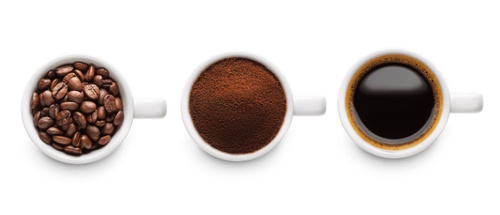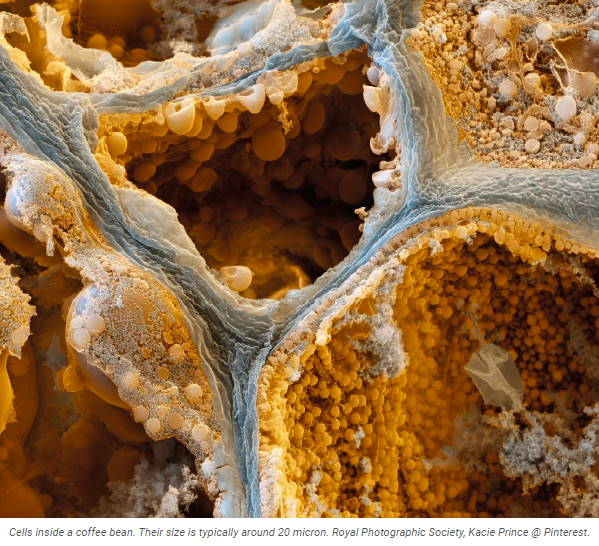The Science of Ground Coffee – Understanding the mechanics of coffee extraction and flavour

This article has been reviewed for accuracy by Dr. Richard Muhlack, Senior Lecturer at the University of Adelaide’s School of Agriculture, Food, and Wine.
Introduction
At face level, the process of brewing coffee does not seem complicated – roasted coffee beans are ground to a powder and then soaked in water to extract the flavour. In practice, however, the process of getting the best flavour from coffee is not a simple one, and generally requires considerable expertise. Baristas who can consistently serve excellent coffee are a highly sought-after commodity, and their places of business are worthy of note.
The reason for this is that coffee is not a simple beverage. A coffee bean is a complicated structure filled with a complex mix of chemical compounds. How finely the beans are ground, the method used for extracting the coffee flavour, the temperature of the water, and the length of time the water is exposed to the coffee all change the mix of compounds released by the coffee beans in a dynamic way, meaning what we broadly call a “cup of coffee” could contain a thousand different mixtures of coffee compounds, and thousands of potential flavours, each subtly different.
So what are some of the variables at play that make the brewing of coffee such a complicated process?
Why is the flavour of coffee so complex?
What you smell and taste in a coffee cup is an incredibly intricate mixture. When you brew a cup of coffee, around 2,000 different chemical compounds are extracted from the ground coffee[1] to end up in solution in the water. Coffee contains Acids and anhydrides, including Quinic acid and Dicaffeoylquinic acid, Alkaloids, including Caffeine, Putrescine, Theophylline and Trigonelline, Alcohols such as Acetoin, Amines including Harmane and Norharman, Ketones, Organosulfuric compounds such as Dimethyl disulphide, Phenols, and Triglycerides (commonly called coffee oils).

However, because coffee beans have a complex physical structure, these compounds are not all released in the same way or at the same rate. The method of preparation and size of the coffee granules can also significantly affect the mix of these compounds. In practical terms, this means that no two cups of coffee will ever be precisely the same – there are simply far too many variables at play.
Defining terms – total dissolved solids and average extraction yield for coffee
Two critical factors when discussing the extraction of the coffee flavour from the ground beans are the total dissolved solids and the average extraction yield.
The total dissolved solids (TDS) is a straightforward measure of the amount of coffee matter in the water. Effectively it’s the percentage of the liquid made up of coffee matter extracted from the beans. On average, a standard shot of espresso typically has a TDS value between 7% and 12% – meaning a 100g of espresso will contain around 7g-12g of compounds extracted from the ground coffee. A cup of black coffee made with a drip filter is much more dilute, normally with a TDS value of around 1.3% to 1.45%.
Obviously, diluting the solution lowers the TDS value, as there is now proportionally more water for the amount of coffee.
The average extraction yield (EY) effectively represents what percentage of the ground coffee bean has dissolved into the water. This figure goes up over time as the water progressively dissolves more of the content of the ground beans, and the ideal range for coffee is normally between 18% and 22% EY[2]. There is a functional limit to how high this number can go – generally around 28% – 30% – as around 70% of the coffee bean’s mass does not dissolve in water. Ideally, this figure is never reached though, as coffee that has been allowed to brew to 28% EY is unpleasant to drink. An EY of 18% – 22% is generally regarded as the optimal range for coffee – although this does not guarantee a good coffee flavour.
Release rates of coffee flavour compounds
One of the key factors that complicates the coffee brewing process is that when the coffee is immersed in the water, different compounds are released at different times. Some of these compounds are essential elements of the taste of coffee. Others are unpleasant and undesirable. Fortunately, many of these less pleasing tastes are released far more slowly than other flavours. But this does mean optimal coffee extraction requires careful timing.
The first compounds to be released include many acids and sour flavours, which are extracted very quickly by the hot water. This means that if coffee is not brewed long enough, it will likely have a flat, sour coffee taste. This generally occurs at an average extraction yield of 18% or less and is normally referred to as the coffee being “under-extracted“[3].
As the extraction process progresses, the coffee will begin releasing medium-speed compounds. These include many of the sugars and sweeter elements contained in coffee beans. These compounds provide some of the most desirable flavours in coffee and serve to balance the sour tastes of the acids and other early compounds – meaning they’re sometimes referred to as the balancing flavours. These generally occur at EY values of 18% – 22%.
If allowed to progress long enough, the brewing process will eventually begin to extract the less desirable slow-release compounds. These include many bitter flavours and often give the coffee a bitter, astringent taste (meaning it tends to dry the mouth). These are generally seen at EY values of 23% and over, at which point the coffee is referred to as “over-extracted”.
It should be noted that caffeine is actually one of the earlier compounds extracted in the brewing process, meaning that over-extraction has very little impact on the caffeine content of the coffee. As such, the popular assumption that people receive an intense caffeine hit from dark, bitter coffee left to brew too long is fictional – a well-balanced coffee with an EY of 20% and a badly over-extracted coffee would have very similar levels of caffeine.
Salty coffee – is salt a solution for over-extracted coffee?
The popular understanding that bitterness in coffee can be neutralised or lessened with the addition of salt does have some scientific basis. It is scientifically established that table salt (sodium chloride) can suppress our perception of bitterness[4], meaning adding small amounts of salt can counter the bitterness of over-extracted coffee.
It should be noted, however, that care should be taken when adding salt, as overly salty coffee is likely no more palatable than bitter, over-extracted coffee.
The effects of granule size on flavour release
Unfortunately, the dynamics of coffee extraction are not only limited to the release rates of fast, medium and slow compounds from the coffee granules. The size of the granules is also a significant factor, and the relationship between grind size and flavour is a little more complex than “fine grinds for quick brewing, coarse grinds for slow brewing”.
Coffee granules vary greatly in size, depending on the grinding process. Broadly speaking, fine coffee grounds – such as those used in espresso extraction – tend to have an average particle size of around 0.2mm – 0.3mm, or 200-300 μm (micrometres)[5]. Coarse grinds can have an average size of around 1000 μm (1mm) or even larger.
It’s also important to remember that the key term here is average size – coffee grinds almost always consist of a range of granules of varying sizes. In particular, most coffee grinds – both coarse and fine – include larger particles known as “boulders” (100 μm and larger), and smaller particles known as “fines” (under 100 μm). It is thought that boulders are whole chunks of coffee bean broken apart by the grinding process, whereas fines are the shrapnel ejected as each break occurs – which is why boulder size is relative to how finely the coffee is ground, while fines remain the same size but are more numerous in finer grinds[1].
These differing-sized particles significantly affect the flavour extraction process, meaning coarser coffee grinds actually behave differently from finer ones during extraction.
How far does water penetrate ground coffee beans?
When coffee is brewed, the coffee granules do not break down and dissolve. Rather, 70%-80% of their physical structure remains, and so to extract the coffee flavour, the water needs to permeate through the coffee bean cells, dissolve the compounds inside, and then flow back out. This is a process that takes some time, as the structure of the cell is complex.

In the time taken for coffee to brew, there is also a finite limit on how deeply the water will penetrate each coffee granule. In some experiments with filter coffee, the water was shown to penetrate to approximately the fifth layer of coffee cells in a coffee granule – a depth of around 100 μm[6] (coffee cells are generally around 20 μm in diameter). There are several reasons this is significant to the coffee extraction process. Firstly, it means that for larger grinds, only a portion of the coffee flavour is extracted – the water will not penetrate deeply enough into a larger granule to extract the flavour compounds held in the inner cells.
Secondly, it can significantly change the flavour profile of the coffee, as it means the compounds within the cell are being released at a range of different speeds.
Staggered release of flavour compounds for larger granules
We’ve already established that coffee cells have fast, medium, and slow-release flavour compounds, and that optimal coffee flavour is generally achieved by extracting the fast and medium-speed compounds and avoiding the extraction of the bitter slow-release flavours. With very small coffee particles, this is a fairly quick process. When the water only needs to soak into the outer one or two layers (which have been broken open by the grinding process), the coffee compounds will be released swiftly at a fairly consistent rate. This form of coffee extraction is known as erosion[6].
Even where the water needs to penetrate down a few layers, for a small granule, the volume of the inner core layer is far smaller than that of the outer layer. As such, most of the coffee flavour compounds will be released at a similar speed, with only a small proportion of the coffee bean (at the core of the granule) being potentially under-extracted.
With coarser grounds and larger granules, this gets rather more complex. While the compounds on the outer layers are extracted reasonably quickly, the compounds in the deeper layers are extracted rather more slowly as the water soaks down through pores in the coffee cell walls, dissolves the compounds inside, and then flows back out again. This process is known as diffusion[7].
Also, in a larger granule, the difference in volume between the outermost layers and the second and third layers is far less significant, meaning the volume of flavour compounds coming from the inner layers of the granule could be equivalent to or even greater than the coffee flavour from the outer layers.

The effect of varied granule sizes on flavour
Extracting coffee flavours from different layers at different rates can complicate the process of extracting the best flavours from the coffee. The main risk is that the flavour from the outer layers would be extracted quickly (including the bitter compounds associated with over-extraction), while only the more sour compounds have been extracted from the deeper levels – meaning in a worst-case scenario, the coffee could be both bitter and sour tasting at the same time (with the bitter over-extracted flavours from the outer levels, the sour compounds from all layers, and only the sweeter flavours from the outer and middle layers to balance that sourness)[8].
The figure below illustrates this. When flavour can be extracted purely from small particles via erosion, the process is not complicated as the various compounds extract at the same rate – this happens very quickly through erosion (although we’ll look at potential complications of very fine grinds in the next section). For smaller granules with 2-3 layers of cells for the water to soak through, the process is slightly more complex – balanced flavour is still possible, but the margin for error is less, and the likelihood of over or under-extracting (achieving a sour or bitter flavour) is higher.

For large granules, it is quite possible to achieve both bitter and sour flavours in the coffee, with bitter compounds from the outer layers being extracted before the inner layers have begun releasing their balancing flavours – meaning bitter, slow-release flavours can emerge before the fast-release sour flavours have balanced out.
This process is even more complicated when a range of granule sizes are present – as is often the case with ground coffee, particularly for coarser grinds. As illustrated in the figure below, the bitter flavours from smaller granules and outer layers can emerge before the majority of flavours are extracted from the larger granules.[9]

The mix of different granules also affects the overall flavour. The best-case extraction time shown in the figure might work for a high volume of small and medium granules. If a significant number of larger granules were present, the overall mix may taste relatively flat and sour, as much of the coffee would be under-extracted.
The risks of grinding too fine
Given that coarse granules make the process of extracting a smooth coffee flavour more complex, is it logical to assume that the best method to extract smooth coffee flavour is to grind coffee as fine as possible – also speeding up the extraction process? Unfortunately no, as this has its own potential issues. Although various coffee brewing methods use fine grinds (such as an espresso machine), experimental evidence has shown that at a certain point, grinding coffee finer actually results in a less consistent taste.
The reason for this is generally because of clogging. When ground fine enough, coffee begins to pack together so tightly that water cannot easily or quickly soak through it. In engineering this is referred to as the Kozeny-Carman equation. When this occurs, in some brewing methods, the water can tend to carve channels through the coffee through which most of the hot water flows[10]. This can mean the areas near those channels are rapidly and thoroughly extracted by erosion, but the water never penetrates the clumped coffee between the channels, meaning that flavour is never extracted. In some ways, this means the tightly clumped areas of fine coffee behave similarly to very large coffee granules – with surface areas near the water that are very rapidly extracted, some lower layers that extract more slowly, and large areas of coffee inside the clump which are never extracted as the water never reaches them.
The worst case scenario is that most of the coffee would not be extracted (as the water would not penetrate into the dense clumps of coffee), but the flavour that was extracted might be over-extracted. Meaning what little coffee flavour you did get would be bitter and unpleasant.
As such, the practical reality is that for many coffee brewing methods, there is often an optimum grind size for best extraction. Any larger and the large granules extract less effectively. Any smaller and the water might not penetrate into the clumps, creating similar problems to coarser grinds.
Coffee extraction with different brewing methods
Although the mechanics of coffee extraction apply to all coffee production, different brewing methods provide different solutions to the problem of getting a balanced flavour from the beans.
For example, espresso extraction uses a relatively fine grind and forces the water through the coffee at high pressure and temperature. As such, the process to extract espresso relies almost exclusively on erosion, with diffusion playing little or no part in the process[6]. The high temperature also increases the rate at which the water permeates into the granules to extract the flavour compounds. The beans are ground fine enough to provide the maximum possible surface area without causing significant clogging, and extraction all takes place within the space of around 25-40 seconds[10].
Conversely, filter coffee is a much slower process, allowing three to four minutes for the water to filter slowly through the ground coffee. Filter coffee normally uses a courser grind to allow the water to flow more easily through the ground beans (another example of the Kozeny-Carman equation at work). This means that the filter coffee extraction method is a mix of erosion and diffusion, and its flavour profile is also accordingly different due to the more complicated extraction dynamics through multiple layers of the larger granules.
Turkish coffee is one of the more extreme methods of coffee brewing, using incredibly finely ground coffee beans and leaving the ground coffee in the cup. Unsurprisingly, Turkish coffee is characteristically strong and bitter – reflecting the old Turkish proverb, “Coffee should be Black as Hell, Strong as Death, and Sweet as Love.”[11]
Other methods, such as cold brew, French press, Moka pots, or even coffee bags, each approach coffee extraction differently, and accordingly have a subtly different flavour profile. So although the basic mechanics of extracting coffee flavour with hot water are the same, the process of getting a balanced, pleasing coffee flavour from each method is unique in each case.
Conclusion
The mechanics of extracting the flavour from ground coffee beans are complex. With around 2,000 different chemical compounds being released from a complex organic structure at various speeds, and dynamics of erosion and diffusion through different-sized granules all at play, the number of variables involved with getting a smooth cup of well-balanced coffee is enormous. As such, it’s no wonder that coffee brewing is often considered an art as much as a science, and trained baristas are a valuable commodity in our society.
Although centuries of coffee history and literally trillions of cups of coffee have helped us refine the craft of coffee brewing (humans currently drink 400 billion cups of coffee each year[12]), there is still a great deal to be learned about the coffee extraction process and how to refine it. Coffee is the world’s second most popular drink (second only to water) and is well worth our efforts to understand, refine, and perfect the process of making it.
References:
- Systematically Improving Espresso: Insights from Mathematical Modeling and Experiment – Michael I. Cameron, Dechen Morisco, Daniel Hofstetter, Erol Uman, Justin Wilkinson, Zachary C. Kennedy, Sean A. Fontenot, William T. Lee, Christopher H. Hendon, Jamie M. Foster
- Modeling study of coffee extraction at different temperature and grind size conditions to better understand the cold and hot brewing process – Xiuju Wang, Loong-Tak Lim 2021
- Chemical compounds in coffee that produce aroma and bitterness
- Salt enhances flavour by suppressing bitterness – P. A. S. Breslin & G. K. Beauchamp
- Average particle size of coffee ground for different preparation methods
- The Dynamics of Coffee Extraction – Jonathan Gagne
- Fines: Fine for Espresso, Not So Fine For Filter – Scott Rao
- How to Measure Extraction of Coffee? – Jori Korhonen
- Analysing extraction uniformity from porous coffee beds using mathematical modelling and computational fluid dynamics approaches – Kevin M. Moroney, Ken O’Connell, Paul Meikle-Janney, Stephen B. G. O’Brien, Gavin M. Walker, William T. Lee
- Do we need to rethink the relationship between grind size and coffee extraction? – Alex Bidstrup
- Strong as death, sweet as love: the long rich history of Turkish coffee – Farah Celjo
- Economics of Coffee – Coffee’s Statistics
About the Author:

Lochy Cupit
Author, Content Writer, Storyteller and Wordsmith
Lochy Cupit is a published author, professional content writer, content researcher, multimedia & web developer, youth worker, actor, radio presenter, podcaster, and creative arts specialist. He currently works as a content writer for a professional first aid training organisation. He holds bachelor’s degrees in computer science and multimedia, a masters in creative writing, and a graduate diploma in theology – because “why study just one thing”? He lives in Adelaide with his wife and two highly energetic boys.
Facts Checked By:
Dr. Richard Muhlack thoroughly reviewed this research and provided positive feedback on its quality. He carefully examined the research, and confirmed the accuracy of the information. Dr. Muhlack holds a PhD in Chemical Engineering and has acquired over twenty years of experience in the wine industry through various research and industry roles. His expertise spans across a diverse range of areas including process analysis and simulation, cleaner production, energy efficiency, renewable energy technology, waste treatment, and environmental management.
